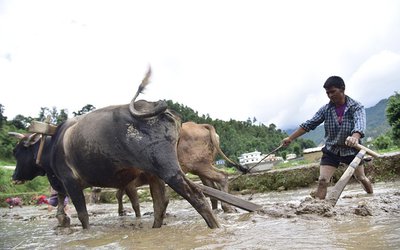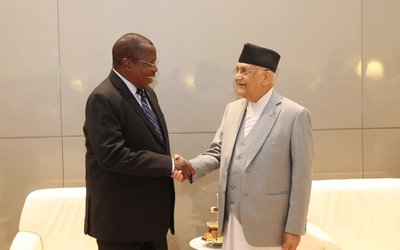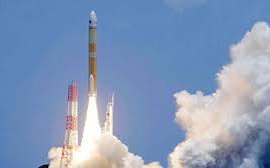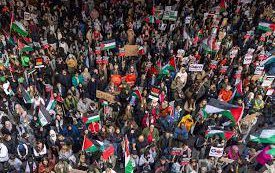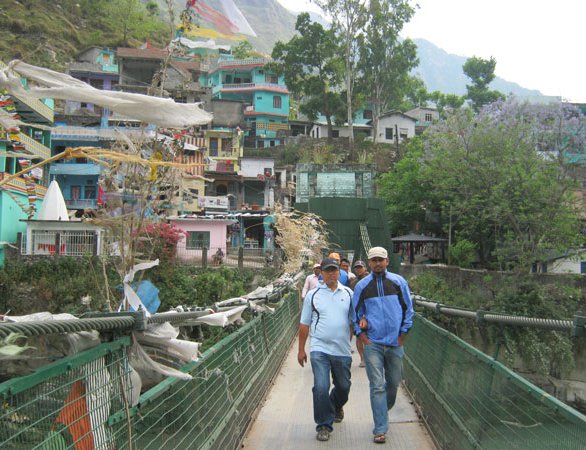
The unique nature of the border, which provides immense economic and social opportunity, needs analysis to understand the deep cultural, religious and human relations between the people living in Nepal and India
Jayman Chand, an Indian citizen and grocery owner of Dharchula in the Indian State of Uttarakhand, did not know what transpired in the Indian capital New Delhi, 500 kilometers southwest, between Indian leaders and Nepal's Maoist leader Prachanda on bilateral matters. Mahakali River on Nepal side, Kamal Pal, a resident of Darchula's district headquarter, Nepal's far-west bordering town, does not know what was going on in New Delhi.
Demarcated by Mahakali River, people living in each side of Nepal-India border have been facing a lot of problems due to the growing security alertness on both the sides. Every day hundreds of Nepalese and Indians cross the Mahakali Bridge. However, they are humiliated by border manning personnel from both the sides when they cross the border.
Presence of Indian Army at Dharchula shows that it is one of the security sensitive parts of India, bordering China. Due to involvement of security, naturally, there may be some implications in border crossing.
Close to the triangular border between India, China and Nepal, the residents of the border on both sides want to maintain harmony and closeness among them. Leaders may speak different languages in different times. However, people living in both sides, who speak the same language, and observe the same culture and same religion, have not many choices.
The harmonious relations and mutual understanding that existed between the people living in both sides of the border is rarely reflected in dealings at the central level. "We need each other for our survival," said Pal. "People living in both the sides survive only when we can protect each other's interests."
People of Darchula have bitter experiences of the past. The aggressive postures of Nepal's comunist party created a lot of misunderstanding. Although Darchula is now connected with Nepal's national highway, people still prefer to travel through Indian roads to come to Nepal. After construction of roads in Nepal's side, even some villagers of India find it easy to go to villages through Nepal.
"We share joy and we share difficulties. We understand each other. What complicates us is petty politics which has nothing to do with us," said Chand.
Although Nepal's customs office and Nepalese customs officers impose many restrictions for the residence of both the sides, their visit to each side of the border has not slowed down. "Since the price of foodstuff in India is much cheaper, we rely on the border market for our day to day livelihood. Similarly, we also carry surplus foods, vegetables, milk products and honey across the border because we get good prices there," said Pal.
People living in both sides of the border share even the festivals. Thousands of Indian pilgrims pay visit to important temples like Malikaarjun, a famous Shiva Temple in Darchula and other sites. Similarly, Nepalese visit annually to different religious sites in Indian side.
There may have been ups and downs in the state to state relations. However, the bond and friendly relations of people living in both the sides have remained intact. From morning to evening, till the closure of the activities, flocks of people pass every day making Nepal-India border one of the most dynamic and economically and socially vibrant borders of the world. There is more love and friendship than anything else here.
With aspects ranging in importance from social to economic and religious to cultural, Nepal-India border reminds the unique nature of border management of the world. There are problems only when there is intervention from the people living outside.
Although Nepal-India open border has so many positive sides for people living in both sides, it is often portrayed as a safe border for the criminals to cross. The media, security officials and populist intellectuals from both the sides narrate the negative stories ignoring the various social, cultural, human, economic and other parts associated with the open border.
The dominant perception among them regarding neighbors is as enemy rather than as a dependable friend. The perception prevalent among the people in both the countries has neither any meaning nor any importance given to local feelings. Although it is the people of both the countries who have to live together in all the times, the policy is decided by Kathmandu based and New Delhi based elites and officials.
"The time has come to close Nepal-India open border because it has badly affected national interest," said Buddhi Narayan Shrestha, who has written a number of books on Nepal-India border. “ Nepal India border needs to regulate to stop illegal arms.”
Utpal Parashar, Kathmandu based correspondent of The Hindustan Times, in the March 26 issue connects terror links and India’s open border with Nepal. In his long column, Indian journalist Parashar narrated a list of events to prove his argument that Nepal-Indian open border is often used by miscreants.
"Former Indian Army chief General Deepak Kapoor made this assertion during a meeting of the then US National Security Advisor James Jones, with defense minister AK Antony and defense ministry officials in New Delhi in June 2009. Replying to a query by Jones on the percentage of infiltrators from Pakistan that manage to get through, Kapoor estimated it to be around 15-20%. while citing the challenge posed by India’s open border with Nepal. Besides militants, the open Indo-Nepal border is used to ferry fake Indian currency from Pakistan to India. The same route is taken to smuggle arms into India—both fake currency and arms are then used to fund militant activities and carry out terrorist attacks. Nepal has been a safe haven of sorts for not just militants from Jammu and Kashmir, but also for terror outfits of north east India, " writes Parashar.
Most of the media coverage on both the sides represents the security views. They ignore the human relations. Nepal-India's informal trade is much higher than what is officially registered. There are more cultural and religious exchanges between the people living in both the sides. Nepalese minister Chhabi Raj Panta, in his recent remarks, raised the issue of free movement of Indian vehicles to Nepal. Ministers and officials often speak rhetoric, rather than the reality of the people's mind.
A Bit Of History
In his paper presented to Friedrich-Ebert-Stiftung Nepal on Prospects, Problems and Challenges of Nepal-India border, Vidya Bir Singh Kansakar, Professor and Head of Central Department of Geography writes before the signing of the Sugauli Treaty between Nepal and India and subsequent demarcation of the Nepal India boundary, there existed a free and unrestricted movement of people of Nepal and India across the border. ”Nepal-India border is unique in the world in the sense that people of both the countries can cross it from any point, despite the existence of border check posts at several locations. The number of check posts meant for carrying out bilateral trade is 22. However, only at six transit points out of them, the movement was permitted to nationals of third countries, who require entry and exit visa to cross the border. As the whole length of the border except police does not patrol the check posts or paramilitary or military forces of either country, illegal movement of goods and people is a common feature on both sides of the India-Nepal border," writes Kansakar in his article.
“Socio-cultural similarities on either side of the international border, a universal phenomenon, are more pronounced in the case of Nepal-India border, because such ties have been enhanced by open border with no restrictions on the movement of people on either side. Social and cultural similarities do exist along the Nepal China boundary as well but more so in the case of Nepal India border where people have easier access and interaction. Ethnic and linguistic similarities exist along the Nepal-India border both in the south plains and hills in the east and west. The open border has naturally promoted social and cultural interaction among the nationals of both sides through matrimonial relationship as well.”
The open border has economically benefited the nationals inhabiting both sides of the border. Those engaged in agriculture have economically benefited from the sale and purchase of agriculture and livestock products in hat bazaars taking place regularly in different places on either side. The increasing urbanization and growth of towns in the Tarai and along the border inside Nepal has resulted in large inflow of goods from Indian side into Nepal. The open border has provided employment to the people on both sides in the transport sector as well.
As there are motorable roads on both sides of the border, construction of motorable bridge across the Mahakali will be another boon to the people of both the sides. Pal and Chand are expecting this to happen so that they can move in each other's places with comfort.

Keshab Poudel
Poudel is the editor of New Spotlight Magazine.
- FOURTH PROFESSOR Y.N. KHANAL LECTURE: Nepal-China Relations
- Jun 23, 2025
- Colonel JP CROSS: Centenary Birthday
- Jun 23, 2025
- REEEP-GREEN: Empowering Communities with MEP
- Jun 16, 2025
- BEEN: Retrofitted For Green
- May 28, 2025
- GGGI has been promoting green growth in Nepal for a decade: Dr. Malle Fofana
- May 21, 2025




